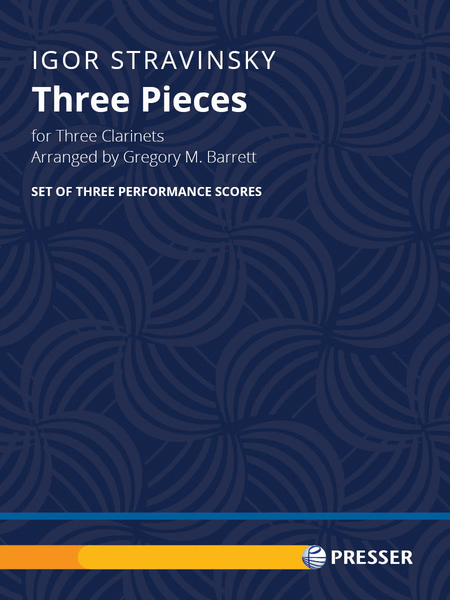Details
Description
SKU: PR.114424090
Composed by Igor Stravinsky. Arranged by Gregory Barrett. Set of Score and Parts. 8+16 pages. Duration 5 minutes. Theodore Presser Company #114-42409. Published by Theodore Presser Company (PR.114424090).ISBN 9781491137383. UPC: 680160690107.
Stravinsky’s 1918 Three Pieces for Solo Clarinet has long been savored by clarinetists as a rare gem in the instrument’s repertory, full of rhythmic drive and Stravinsky’s jazzy neo-classicism. Composer and clarinetist Gregory M. Barrett’s remarkable adaptation for 3 clarinets is a tour de force, assimilating Stravinsky’s harmonic, rhythmic, and contrapuntal style to create a striking addition to the clarinet literature.
Igor Stravinsky’s Three Pieces for Solo Clarinet (1918) is a core work in clarinetists’ repertoire, and I havereimagined it for the convivial grouping of three players. The arrangement contains all of Stravinsky’soriginal, but now his solo line is shared among three in a new matrix of harmony, imitation, andcounterpoint.The molto tranquillo first piece develops from the emphasized C# in Stravinsky’s first measure andmoves to a somewhat somber mood when C# is revealed to be the dominant of F# minor. Withincreasing expansion of tessitura in the sustained harmonies, the sun comes out in the last phrase with ajoyous Eb major chord.The circus-like second piece finds the three clarinets whirling in the air in synchronized trapeze artiststyle. The emphasis is on imitation and fluid hand-offs. Chords with major 7ths and 2nds contrast withtriadic harmony. Following the cat and mouse middle section, where dancing patterns of twos andthrees alternate, the summit of the big top is reached again just before the players settle down to earthwith a welcome C major chord of respite.The ragtime burlesque of Stravinsky’s third piece is heightened by homophonic rhythm among the threeplayers. Each clarinet part has its own specialty. Clarinet 1 loves 32nd notes, Clarinet 2 shows off with fasttriplets, and Clarinet 3 likes the low notes and in general supporting its friends. Quartal harmony withstacked 4ths is emphasized, but where Stravinsky’s melody suggests triads, I have taken his hint. Thepropulsive rhythms are truly exciting, and with the wink of an eye, the music ends all too soon.

 Share
Share